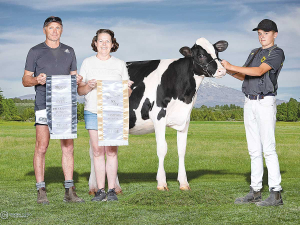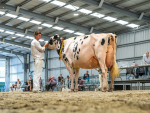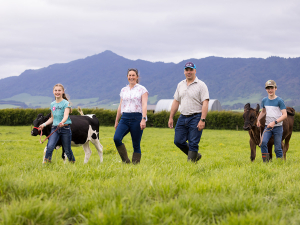"We are just loving it," he says. "It's beautiful."
Newlands, with wife Lee Morris and 14-year-old son Toby, milk 50 registered pedigree Holstein Friesian cows on 40ha at Puahue, in the Waikato, under the name Glenidol.
Despite the Whytocks owning the property and milking cows to rear calves since 2005, it has only been supplying factory milk for the last 18 months.
The family have undertaken extensive renovations of the farm infrastructure, while buildig a small but incredibly high quality herd of cows - with "buy the best, breed them better" at the heart of their strategy.
"We are starting later in life, so we have to start up the scale a bit," Newlands says. "We're a small business, so we want good, beautiful cows."
Today, Newlands runs the farm, while Lee - an equine veterinarian - runs her company EquiBreed ART, the centre for equine advanced reproductive technologies in New Zealand.
Having grown up in NSW, Australia, Lee always wanted to be a vet and started out as a beef cattle vet in northern NSW; she also spent time on her grandfather's merino sheep farm, Glenidol, and enjoyred riding horses.
Newlands grew up locally, near Cambridge, on a 25 acre farm where his job was to milk their house cow daily. He spent a lot of time with his neighbour, Mr Rye, who milked 30-40 Holstein Friesian cows.
As a 15-year-old Newlands worked for Bill Montgomery (Ngapuka Holstein Friesians) on the town milk supply, as a farm cadet.
"Bill had great cows," he says. "That's probably where my love of Holstein Friesians began. I love their colour, I love their patterns. Black and white cows are hardy. They're just beautiful cows."
Newlands later moved to another farm to fulfil his cadetship requirements but long working hours for little pay saw the end of his farming career. At 18, he sat his heavy vehicle license and started driving trucks.
"I wasn't your typical truck driver - I saved all my money," Newlands says. "It was always my intention to work and save for my farm. When we bought this place in 2005 I had the deposit and Lee had the salary to back it up."
In 2008 the couple looked at converting the Puahue farm to dairy, but the opportunity came up for Lee to purchase Equibreed from Matamata Vets and bring the business home.
“We couldn’t do both, so we bought Equibreed and we worked on that together while I reared calves, which I loved, and fenced,” Newlands says.
In 2022, they were able to sell the successful business back to Matamata Vets, with Lee keeping the embryo lab side of the business.
“It was time to live the dairy farming dream. I called Doug Courtman (Carse-O-Fern) and said, I’ve finally grown up and I’m going dairy farming – I need some advice.”
Doug encouraged Newlands to attend the Okawa (Tim and Jo Barclay) sale, where he ended up purchasing 14 cows, including Okawa Doorman Rosa VG85 and Okawa Platnum Tara GP84.
“I wish I’d bought more; they are beautiful cows,” Newlands says.
Reaping the Rewards
The farm had an existing 10-a-side herringbone cowshed that was renovated and upgraded to a 12-a-side shed.
While the new shed was being built, the cows were trucked to Waipiri Holsteins (David and Pip Fullerton), Carse-O-Fern, and the Whytocks’ bank manager’s farm, who kindly milked their cows for them.
The first milk pick-up from the new shed was in December 2022.
Originally the cows were transitioned to autumn calving to co-ordinate with the horses living on farm, but since Equibreed has moved off farm this decision may be revisited in the future.
The Whytocks’ show cows are spring calving, so they have ended up milking year-round.
The family is starting to reap the rewards of last year’s sire selection.
“We are seeing some great Silverridge V Einstein, Novum Mercy and Farnear Delta Lambda-ET calves coming through,” Newlands says. “It is so exciting. I can’t wait until they are two-yearolds.”
Mating is a flexible process. This year, the Whytocks started their embryo programme in April, a little earlier than usual due to Toby being away at school in May. And, heifers were due to be synced on May 19, and cows June 1.
Toby selected all bulls for this mating.
“I let him go for it this time but next year, he is going to have to tone it down a bit,” Newlands laughs. “He’s got bulls from World Wide Sires, Semex, STgenetics… including Beyond Overdo Hardin- ET and Ocd Trooper Sheepster-ET.”
He says Toby’s interest in the farm has been wonderful to see.
“He’s so excited about it,” he says. “He used to come out on the farm, but he’s gone to the next level. He’s milking, learning to drive the tractor – I’m so proud of him.”
Newlands says for him, production traits comes first, then type.
“Being so small we’ve got to pick on production,” he says. “We are targeting 600 kgMS. We’ve got some amazing cows that are doing over that, but that’s what we’re targeting with what they’re being fed – 6kg/cow/day of grain in the shed, ad lib grass during the day, and maize silage and baleage when they’re in the barn overnight.”
Low BW sires are avoided unless they are used over the Whytocks’ show cows.
Earlier this year, the family showed Glenidol Lambda Cookie, out of Tahora Octane Cookie VG88, at the NZ Dairy Event and won the titles of Holstein Friesian Junior Champion and Supreme Junior Champion.
“We didn’t go to NZDE with any expectations,” Newlands says. “What a sensational feeling it was to win. Now, we’ve got to back it up; we’ve got great cows, now we need to breed them.”
The Whytocks are not short on supportive, encouraging breeders to help them along their journey, citing Dean Geddes, Tim Barclay, Jo Dorn, Warren Ferguson and David Fullerton as being particularly influential.
“Dean, Tim and Jo are kept updated on our cows regularly, and they are happy to give us advice,” Newlands says. “They are really inspiring people. The Fergusons and the Fullertons have also been a fantastic support.”
Newlands says their plan going forward is somewhat fluid.
“Who knows where to from here? We looked at buying a bigger farm, but we are freehold now so why would we put ourselves under pressure at this age?
“This place is mint. We will potentially look at increasing herd numbers to around 70 cows and expanding the composting barn, with the help of our environmental planner.”


















